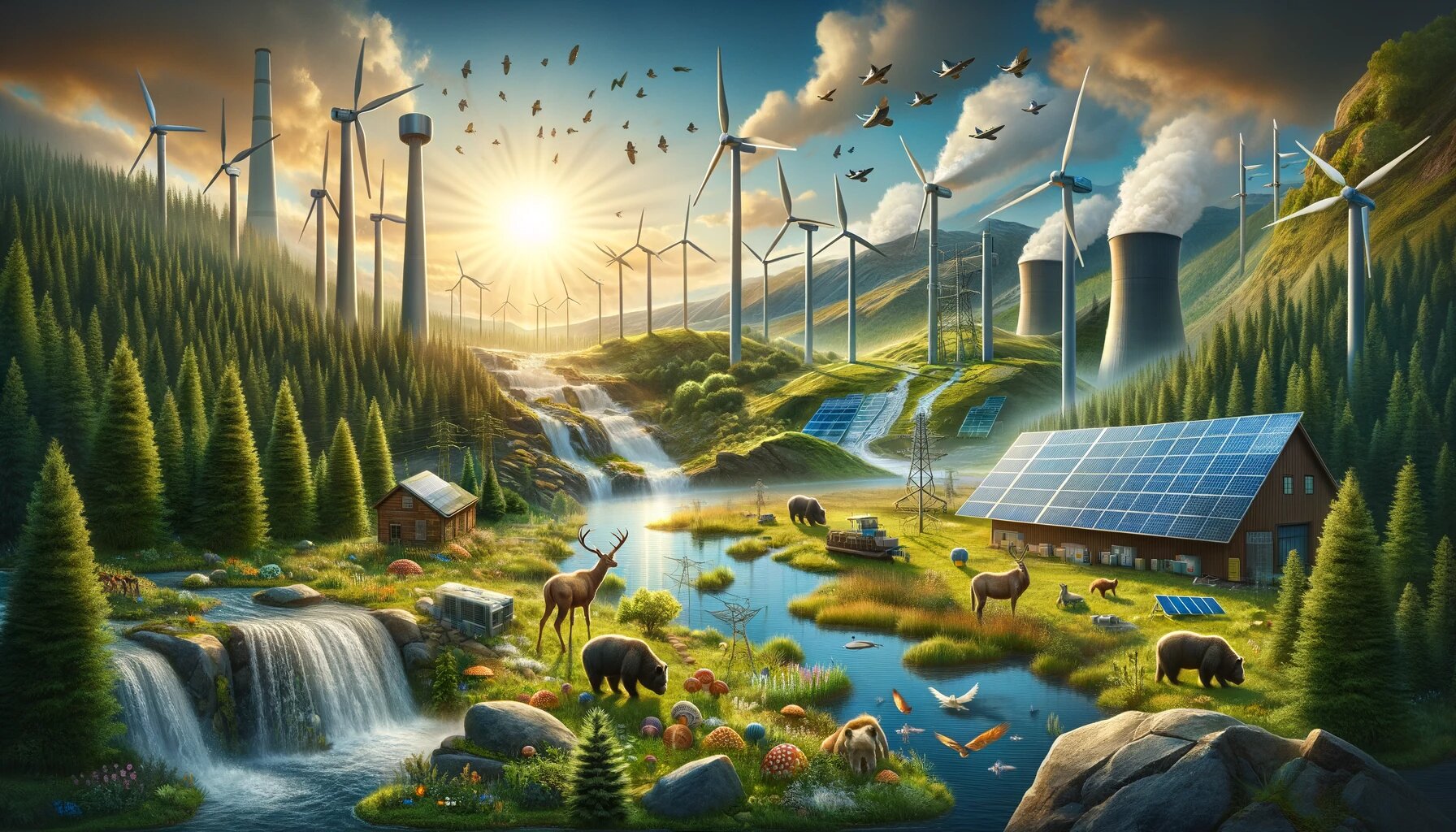Climate change is one of our most pressing global challenges, with far-reaching environmental, social, and economic consequences. It is primarily driven by the release of greenhouse gases, such as carbon dioxide (CO2), into the atmosphere due to human activities, including burning fossil fuels for energy production. To combat climate change and limit its adverse effects, the world must transition to cleaner and more sustainable sources of energy. Renewable energy sources, such as solar, wind, hydroelectric, and geothermal power, play a pivotal role in this transition. In this article, we will explore the crucial role of renewable energy in mitigating climate change and its various environmental and economic benefits.
1. Reducing Greenhouse Gas Emissions
The combustion of fossil fuels for electricity generation, transportation, and industrial processes is the largest contributor to global greenhouse gas emissions. These emissions trap heat in the Earth’s atmosphere, leading to global warming and climate change. Renewable energy sources offer a way to produce energy without the direct release of greenhouse gases, making them a key solution for reducing emissions.
1.1 Solar Energy
Solar energy harnesses the power of the sun’s rays to generate electricity. Solar panels convert sunlight into electricity through a process known as the photovoltaic effect. Unlike fossil fuels, solar power generation does not produce harmful emissions, making it a clean and sustainable energy source. Widespread adoption of solar energy can significantly reduce CO2 emissions associated with electricity production.
1.2 Wind Energy
Wind energy is another renewable source that does not emit greenhouse gases during electricity generation. Wind turbines convert the kinetic energy of wind into electrical power. Replacing fossil fuel-based power plants with wind farms can significantly reduce carbon emissions and combat climate change.
1.3 Hydropower
Hydropower, generated from flowing water, is a well-established renewable energy source. Unlike coal or natural gas power plants, hydropower facilities do not release CO2 during electricity production. Additionally, hydropower can act as a reliable source of baseload power, helping reduce the need for fossil fuel backups.
1.4 Geothermal Energy
Geothermal energy taps into the Earth’s internal heat to generate electricity and provide heating and cooling solutions. Geothermal power plants emit very low levels of greenhouse gases compared to their fossil fuel counterparts. By expanding the use of geothermal energy, we can further decrease emissions from the energy sector.
2. Energy Independence and Security
Reducing our dependence on fossil fuels through the adoption of renewable energy sources enhances energy security and independence. Traditional energy sources are subject to price volatility and geopolitical conflicts, disrupting energy supplies and leading to economic instability. On the other hand, renewable energy is domestically produced and less vulnerable to such fluctuations, helping countries achieve energy independence.
3. Job Creation and Economic Growth
The transition to renewable energy sources can stimulate economic growth and job creation. The renewable energy sector has experienced rapid expansion in recent years, leading to the creation of numerous jobs in manufacturing, installation, maintenance, and research and development. Investments in renewable energy technologies also contribute to economic growth and innovation.
4. Improved Air Quality and Public Health
Fossil fuel combustion releases greenhouse gases and produces harmful air pollutants, including particulate matter, sulfur dioxide, and nitrogen oxides. These pollutants contribute to air quality degradation and have severe health consequences. Replacing fossil fuels with renewable energy sources can reduce air pollution, leading to cleaner air and better public health outcomes.
5. Mitigating the Impact of Climate Change
The consequences of climate change, such as rising global temperatures, more frequent and severe weather events, and sea-level rise, pose significant threats to ecosystems, communities, and economies. Renewable energy plays a vital role in mitigating these impacts.
5.1 Climate Resilience
Renewable energy systems, particularly distributed ones like solar panels, can enhance climate resilience at the community level. By decentralizing energy production and storage, communities can become less reliant on centralized power grids that are vulnerable to extreme weather events and natural disasters.
5.2 Reducing Heat-Trapping Gases
The widespread adoption of renewable energy sources reduces the release of heat-trapping gases, helping slow down the rate of global warming. This, in turn, can alleviate some of the most devastating consequences of climate change, such as extreme heatwaves, melting glaciers, and disruptions to ecosystems.
5.3 Ocean and Ecosystem Protection
Renewable energy can also mitigate the impact of climate change on oceans and marine ecosystems. Rising ocean temperatures and ocean acidification, both driven by increased CO2 levels, threaten marine life. By reducing CO2 emissions through renewable energy adoption, we can help protect these vital ecosystems.
6. Global Cooperation and Sustainable Development
Global cooperation and sustainable development are two intertwined concepts critical for addressing the pressing challenges facing our world today, particularly in the context of climate change and environmental preservation. These concepts emphasize the need for countries and organizations to work together collaboratively to achieve a more sustainable and equitable future for all.
Sustainable development is a holistic approach that balances economic growth, social well-being, and environmental protection. It recognizes the interdependence of these factors and aims to ensure that current and future generations can meet their needs without compromising the Earth’s natural resources and ecosystems. Achieving sustainable development requires local and national efforts and international cooperation, as many of the world’s challenges transcend borders.
Global cooperation is the linchpin of sustainable development. It involves nations, governments, international organizations, NGOs, and businesses coming together to address common challenges, share knowledge, technology, and resources, and promote equitable solutions. Global cooperation is essential in climate change to reduce greenhouse gas emissions, develop resilient infrastructure, and adapt to the changing climate.
Moreover, global cooperation fosters partnerships and solidarity among countries, promoting peace and stability. It provides an opportunity for developed nations to assist developing ones in their pursuit of sustainable development goals, ultimately reducing poverty and inequality worldwide.
In conclusion, global cooperation and sustainable development are inseparable and vital components of addressing our planet’s complex challenges. By working together across borders and across sectors, we can ensure a more prosperous, equitable, and environmentally sustainable future for all.
7. Overcoming Challenges
While renewable energy sources offer numerous benefits in the fight against climate change, they also face challenges that must be addressed for their widespread adoption.
7.1 Intermittency and Storage
Some renewable energy sources, like solar and wind, are intermittent and dependent on weather conditions. To overcome this challenge, advances in energy storage technologies, such as batteries, are crucial for storing excess energy and ensuring a continuous power supply.
7.2 Infrastructure and Investment
Transitioning to renewable energy requires significant investments in infrastructure, including the development of renewable energy plants and grid upgrades. Policymakers and governments must create favorable private and public investment conditions to support this transition.
7.3 Energy Transition Workforce
As the energy sector evolves, there is a need for a skilled workforce capable of operating and maintaining renewable energy systems. Educational and training programs should be developed to meet this demand.
Conclusion
The role of renewable energy in mitigating climate change cannot be overstated. By reducing greenhouse gas emissions, enhancing energy security, creating jobs, improving air quality, and mitigating the impacts of climate change, renewable energy sources offer a multifaceted solution to one of humanity’s greatest challenges. To successfully combat climate change, it is imperative that governments, businesses, and individuals continue to invest in and adopt renewable energy technologies on a global scale. We can only secure a sustainable and resilient future for our planet and future generations through collective effort.

